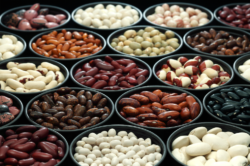 Lately, and with increasing frequency, I have been tasked with explaining how to safely prepare and handle dried beans. Whether they’re red, white, black, pinto or garbanzo, beans are packed with nutrients. But if they aren’t prepared properly, they can be really hard for you to digest. Proper rehydration, cooking and fermentation (in some instances) can aid in the digestion of these flavor-packed morsels of goodness.
Lately, and with increasing frequency, I have been tasked with explaining how to safely prepare and handle dried beans. Whether they’re red, white, black, pinto or garbanzo, beans are packed with nutrients. But if they aren’t prepared properly, they can be really hard for you to digest. Proper rehydration, cooking and fermentation (in some instances) can aid in the digestion of these flavor-packed morsels of goodness.
Dry beans and peas are favored by many because they are easily stored and shelf-stable. To ease digestion and avoid broken teeth, they must be rehydrated before cooking. Rehydration times can vary from one-hour to overnight, and soaking methods can contain plain water or additives, such as vinegar.
One of the best methods for producing safe and tasty beans that I have found is to wash beans and remove their debris in running water. You should then add liquid until it reaches 2½-3 inches over the beans, regardless of the size of the container or composition of the soaking liquid. (Sometimes I add a small amount of jalapeno vinegar to my water.) If you want tender beans, you should avoid adding any salt to your soaking liquid. Once filled, place your beans in a reach-in or walk-in cooler for the duration of the soak (typically 8-24 hours). An FX Series unit makes this part of the process really simple and convenient.
Traditionally, beans are soaked at room temperature. Unfortunately, there are serious risks involved with this method.
Soaking beans at room temperature promotes fermentation (and yes, the beans get gassy) resulting in (you guessed it) a sour smell. While certain types of fermentation can limit disruptive complex sugars (or oligosaccharides), the situation described above can be unsafe prior to cooking. Wild strains of bacteria that are not good for your digestive system can develop during the soaking stage. Most of the benefits of fermentation are lost during the cooking process, so you’ll be safer and better off waiting until your food is cooked before you try fermenting on purpose.
After the beans have been soaked, you will want to prepare for a long and slow cook in a heavy-bottomed stock pot. But, if you do use a stock pot, you’ll have to keep a close eye on it. If you want the freedom to “set it and forget it,” so that you can save time and work on other food prep tasks, I’d take a closer look at the Groen kettle with its new advanced electronic controls.
Unlike the wild temperature swings and bottom burning you’ll get with the stock pot, or even other kettles, Groen has specifically designed their equipment so that you can simmer food under exceptionally precise temperatures.
Once you finish cooking your beans, you can send them straight to the serving line or chill them with a Randell blast chiller to be rethermed at a later time. You can also rest easier knowing your beans were kept out of the danger zone, limiting your product’s exposure to unwanted fermentation and bacteria growth.
Click here for more information on Groen kettles or Randell’s FX Series and blast chillers.
Note: While doing research on this blog topic, I found some additional information concerning beans and fermentation. The author and I differ on the approach, but we agree on the basics and the bottom line – safe food handling rules the day.
Enjoy the food!
Michael Williams